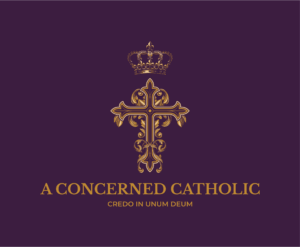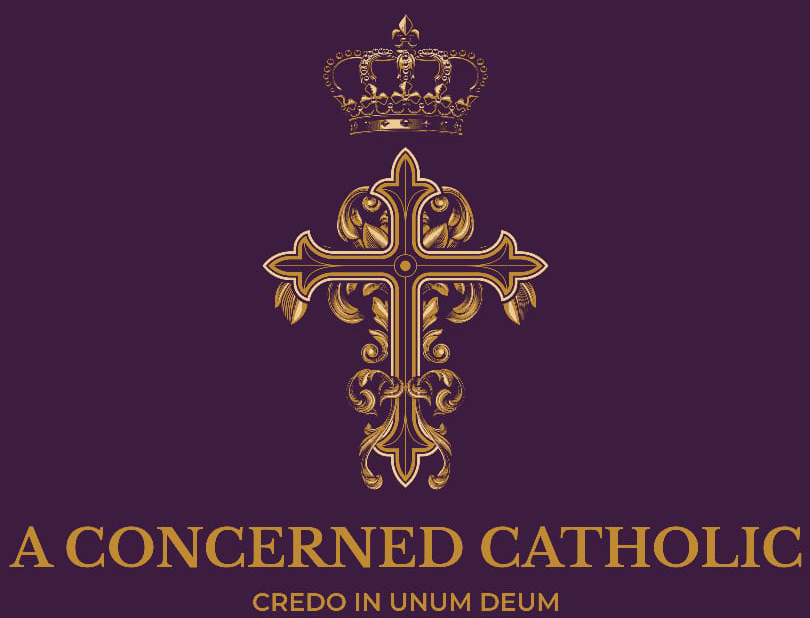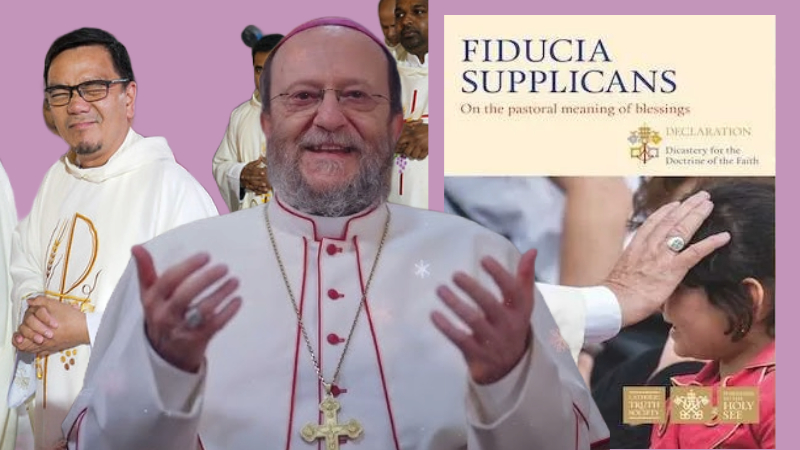(This article will assume you already know a little, or a lot, about the Shroud of Turin. But, if you are not familiar you can use this article as a primer and go on to researching or reading about the most widely known artefact or relic of Our Lord and Saviour)
A new article claiming that the Shroud of Turin, a relic from the first century that is claimed by Catholics and some Christians to be the authentic burial cloth of Jesus Christ, has been doing the rounds, claiming that it is a false relic.
Publishing for the reputed Journal of Medieval History, Nicolas Sarzeaud details the supposed ‘exposé’ of one Nicole Oresme, a French philosopher & scholar of the Middle Ages (1325 to 1382), who also served as the Bishop of Lisieux, a French Diocese.
The Shroud Sceptics ‘claims’
A onetime Roman Catholic, who I will refer to as ‘Thomas’ in this post (after perhaps the first sceptic of Our Lord, and subsequent Apostle to India – St. Thomas), and author of distinct repute and credentials writing about the above article, claimed:
“A leading historian who is an expert on the cult surrounding putative shrouds of Christ between the 14th and 16th centuries has uncovered an explosive document penned by a medieval French monk debunking the Shroud of Turin as a “‘patent’ example of clerical fraud.”
Thomas goes on to state in his article that:
“Sarzeaud uses other 14th-century sources to corroborate Oresme’s claim that the Shroud is fake, including a letter from Pope Clement VII forbidding the Shroud from being displayed as a relic, as well as a ban by the bishop of Troyes, Pierre d’Arcis, on the display of the cloth.” And “While the Shroud’s authenticity has been hotly debated for centuries, this is the second academic article in a brief period to conclude that it is a fake.”
For this Thomas cites another journal that had published an article by Cicero Moraes stating:
“In an article published in the journal Archaeometry on July 28, Cicero Moraes, a specialist in historical facial reconstruction, concluded that Jesus’s image on the Shroud is a low-relief artistic representation and not the direct imprint of a real human body.” And “Moraes found that the Shroud may have been created during the medieval period, aligning with funerary art practices and artistic techniques of the time”.
Thomas then goes on to cite the radiocarbon dating problem that forms the mainstay of those who are sceptical of the Shroud, stating:
“Radiocarbon dating of the Shroud that took place in 1988 and 1989 suggested that the cloth dates to the 14th century.”
In summary, the following is what Thomas takes away (and wants you to take away as well from the article published in the journal):
1) Pope Clement VII prevented the Shroud from being displayed as a relic,
2) The bishop of Troyes, Pierre d’Arcis, banned the display of the cloth.
3) The ‘appeal to authority’ by citing scholar Nicole Oresme, who suspects or rejects the Shroud as being authentic.
4) Cicero Moraes claims that the Shroud was a creation of the Middle Ages based on historical facial reconstruction. And Moraes is credible since he is a ‘specialist’ in his area of expertise.
5) Add the above four points to the view that the 1998 radiocarbon dating of the Shroud indicated that the cloth belonged to the 14th century.
The above points help Thomas to solidify, perhaps reasonably to himself, that we should therefore toss the Shroud into the history bin as a forgery or a fake. However is it actually a reasonable conclusion to consider the Shroud to be a fake?
In his article Thomas gives no mention of what the purported relic actually is – besides theorizing, thanks to the work of Moraes, that it is a likely an artistic representation or painting.
However, there are numerous credible sources which have examined the Shroud of Turin in great detail, & surprisingly none were mentioned in the article by Thomas.
What exactly is the fuss over the Shroud about?
The most important questions regarding the Shroud posed by many since the ‘Shroud of Turin Project’ (STURP), the body that collectively investigated the Shroud perhaps in the greatest of details in its entire history, or even since Secondo Pia (the photographer who captured the now eerie image we know to be of Jesus), have never been answered namely:
(1) How was the image on the Shroud formed if it is a fraud?
(2) Why is this image on the Shroud not reproducible by 21st century technology?
(3) STURP confirmed a number of aspects which match the history & geography of Palestine & manner of Jesus’s death reflected in the Shroud. How are these encapsulated in the Shroud if it is a medieval fake?
Is the Shroud a painting and a ‘work of human hands’?
With respect to ‘How was the image on the Shroud formed, if it indeed was a fraud?’, one can refer the STURP website which has A Summary of STURP’s Conclusions on their landing page which reads as follows (excerpts cited below – you can read their summary in entirety here):
“No pigments, paints, dyes or stains have been found on the fibrils. X-ray, fluorescence and microchemistry on the fibrils preclude the possibility of paint being used as a method for creating the image. Ultraviolet and infrared evaluation confirm these studies. Computer image enhancement and analysis by a device known as a VP-8 image analyzer show that the image has unique, three-dimensional information encoded in it. Microchemical evaluation has indicated no evidence of any spices, oils, or any biochemicals known to be produced by the body in life or in death. It is clear that there has been a direct contact of the Shroud with a body, which explains certain features such as scourge marks, as well as the blood. However,…it is totally incapable of explaining the image of the face…
…there are no chemical or physical methods known which can account for the totality of the image, nor can any combination of physical, chemical, biological or medical circumstances explain the image adequately.
Note that STURP therefore had already addressed the claim by Moraes in point 4 of my summary above, that the image on the Shroud was a “low-relief artistic representation”. STURP on their website go further:
Thus, the answer to the question of how the image was produced or what produced the image remains, now, as it has in the past, a mystery.
We can conclude for now that the Shroud image is that of a real human form of a scourged, crucified man. It is not the product of an artist. The blood stains are composed of haemoglobin and also give a positive test for serum albumin. The image is an ongoing mystery and until further chemical studies are made, perhaps by this group of scientists, or perhaps by some scientists in the future, the problem remains unsolved.”
A book that delves into the Shroud of Turin and the scientific research undertaken by the STURP team really well, is ‘The Resurrection of the Shroud – New Scientific, Medical, & Archaeological Evidence’.
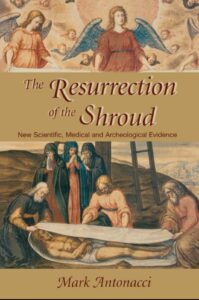
In this book, author Mark Antonacci in chapter three, addresses the following topics (which I add my comment to below):
1) The body image in the Shroud is a negative.
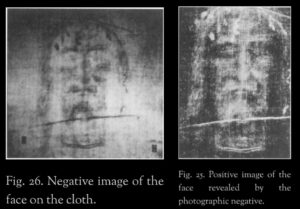
The problem: How does a medieval forger paint or create a negative image of a person, whose positive image could only be obtained with technology in the 19th century?
2) The body image is superficial.
The problem: How can the medieval painting or other such hypothesis for the Shroud being a clever forgery, create an image that exists on the uppermost fibres of the cloth, without penetrating, soaking, and affecting the lower fibres? And we are talking about fibres (fibrils) in the space of micromillimeters.
3) The body image is directionless but was formed along vertical paths.
Through the aid of a high-tech imaging system called a microdensitometer, the STURP team were unable to identify a pattern of direction that would be associated with the brush strokes of an artist’s brush in a painting. What STURP additionally found was that the image could only be produced by an image-encoding process that operated in a vertical direction (from the body-up, to the cloth) – more on this a little later.
The problem: How can the Shroud have a directionless attribute to the image if indeed it were a painting or some form of paint, dye, pigmentation, etc.? Moreover, how could a precision like that of a laser-like encoding be obtained on the Shroud image in a vertical direction to the body, that too in the Middle Ages, when such technology was unavailable?
4) The body image is three-dimensional, formed through space.
Through the aid of another high-tech imaging system called the VP-8 Image Analyzer which works like radar, the STURP team found distance differences in the image from the Shroud. Meaning there was some correspondence in the intensity of the image to the body parts which may have been in closest contact with the Shroud if it was lying over a body (i.e; the nose, chin, or forehead). The Shroud is a flat piece of linen – a two-dimensional object, similar to photographs and paintings. And the expected result was for the VP-8 to produce a distorted image (similar to that obtained of photographs and paintings). Instead, it produced a three-dimensional image of a correctly proportioned man.
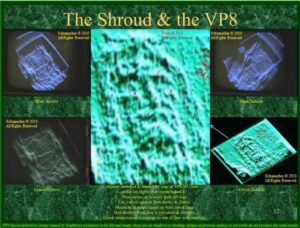
The problem: How can the Shroud image and linen contain ‘distance’ information that could be used to generate a three-dimensional image of a person in the 21st century if it was a product of the Middle Ages, and a forgery?
Let’s circle back to the points made earlier by Moraes (cited by Thomas) that the Shroud is a “low-relief artistic representation”. In chapter four of the book Antonacci cites two tests: spectral study and chemical tests, which rule out the charge of the Shroud being a painting of some kind. In chapter five, the author cites several ‘Naturalistic theories’ that could have been used to reproduce the image such as (1) Vapograph or Diffusion theory, (2) Direct-contact theory, (3) Volkringer method, (4) Singlet oxygen theory (Lomas & Knight), & (5) Bacteria & Fungi as likely methods, apart from stressing how/why STURP found these theories improbable, if not outright impossible.
Antonacci also cites several ‘Artistic theories’ that could have been used to reproduce the image on the Shroud and why STURP ruled these out, such as: (1)Nickell powder-rubbing method, (2) Craig-Bresee method, (3) Heated Bas-relief/Scorch theory, (4) Hot statue method, (5) Radiation and electrostatic fields (Kirlian method or Corona discharge), (6) Engraved lines technique, (7)Kersten and Gruber method, (8) Medieval photography, & (9) Other artistic theories and experiments.
So as can be seen, ‘experts’ such as Moraes (and others) who have concluded that the Shroud is an ‘Artistic representation’ should have the STURP research as their starting point & I am left uncertain if this common-sense baseline method may have been considered by Moraes since the article in Archaeometry is behind a paywall & cannot be readily accessed. If STURP research was factored, it would be useful to see how this stacks up (since the method used by Moraes seems to be 3D digital simulations), especially after considering that STURP had already conducted image scans using the VP-8 image analyser to produce distance information that could render a perfectly undistorted three-dimensional image of a human male (as against ‘a significantly distorted image’ as reported by Moraes).
These are show-stoppers and deal breakers in my humble opinion; aspects that have dealt potential death blows to the beliefs of Shroud sceptics – however, sceptics have let their false zeal continue unabated despite these rather unsurmountable findings & problems.
What can cause an image, such as that on the shroud to form, if it is NOT a fraud?
Speculating how the Shroud image could have been formed, Antonacci in chapter ten cites several scientists from the STURP team, the foremost of whom is scientist John Heller who stated:
“It is as if every pore and every hair of the body contained a microminiature laser”,
and goes on to then deduce that
“this vertical directionality of the Shroud body image has only been accounted for by methods involving radiation”,
Another scientist, Dr Little, cited in this books states:
“Some scientists have suggested something in the way of a nuclear disintegration, acting almost instantaneously, as with the flash of a nuclear explosion”,
While another scientist, Professor McDonald states:
“Many scientists now describe this burst of energy as a pulsed laser beam caused by dematerialization of the body into energy in a millisecond.”
Mentions of gamma rays & neutrons, as a possible explanation of the body image and other secondary images encoded on the Shroud, abound in the tenth chapter leading to a radiation-based energy & light source as the cause of the image.
While the above theories are not experimentally validated conclusions, it is important to note that they are the ideas and thoughts of experts who understand the causation of such images such as that on the Shroud. While these ‘theories or hypotheses’ have not gone unchallenged, with some arguing that the amounts of energy invoked are unrealistic or would have destroyed the cloth or its surroundings, it is important to understand that this argument holds true for a process that is “uncontrolled” or based on current technology. At best, such ‘criticisms’, suffer from being a gargantuan ‘argument from incredulity’ fallacy, translating to: “I cannot imagine how this could be true; therefore, it must be false.”
Therefore “How the image on the Shroud was formed”, is still a mystery as per STURP, although they speculate that it was some form of light/energy radiation that may have caused this.
Why is the image on the Shroud not reproducible by 21st century technology?
If the previous questions were a mystery, the next question is perhaps more mysterious. Why exactly is the image on the Shroud not reproducible by 21st century technology? Is it possibly because, as Rogers, a challenger to STURP, concluded in his own independent critical research of the work by Jackson from STURP,
“Intense radiation exerts pressure as in a nuclear weapon. Radiation pressure coupled with ablation … probably would have torn it (the cloth) to shreds.”?
Consider the subsequent findings in 2010 by the Lazzaro/ENEA workgroup which while admitting to some degree of success stating:
“Though significant, our results allow the recognition of a photo-chemical process capable of generating a Shroud-like coloration…”
followed it up by this ‘Holy cow’-equivalent confession by them:
“…but still do not make it possible to formulate a certain and practicable hypothesis on how the Shroud image was formed: for example, if we consider the density of radiation that we used to colour a single square centimetre of linen, to reproduce the entire image of the Shroud with a single flash of light would require fourteen thousand lasers firing simultaneously each on a different area of linen. In other words, it would take a laser light source the size of an entire building” (emphasis mine).
I am sure those reading the above emphasis by me, muttered a ‘Holy cow’ under their breath. Or something to that extent. Because the source of radiation needed to produce something like the image on the Shroud is huge to say the least. And then to posit that a laser source, the size of a reasonable building, could exist in the medieval ages makes me think of the conclusion arrived at by Lloyd (Jim Carrey) in the 1994 movie ‘Dumb & Dumber’, represented as a meme by yours truly below:
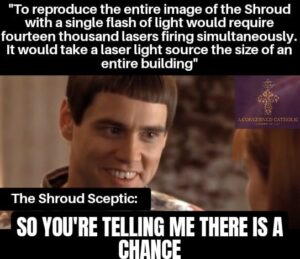
If someone thinks that such a highly ‘impossible’ challenge is ‘possible’ with technology in the future, they are examples like Lloyd who are unable to distinguish between ‘possibility’ and ‘probability’, perhaps hopelessly grasping at straws.
How are aspects that match the history, geography of Palestine & the manner of Jesus’s death encapsulated in the Shroud if it is a medieval fake?
I also stated that STURP confirmed a number of aspects which match the history & geography of Palestine, and the manner of Jesus’s death reflected in the Shroud. Again citing from the book by Antonacci, there are several clues to the origins of the Shroud such as (1) Cotton strands embedded in the linen of the cloth, (possibly due to the Shroud being woven on equipment also used for weaving cotton) found to be a variety that is “characteristic of the Middle East”), (2) coin images found on the eye of the man in the Shroud image date back to Pontius Pilate, and (3) limestone sample and pollen analysis, based on contaminants found in the Shroud, were found to originate in Jerusalem.
Add to the above is the overwhelming evidence of the medical pathology that Antonacci devotes to the man in the Shroud, in the second chapter of his book. That the man in the image is severely beaten, scourged, wounded, crowned with something like a cap of thorns, and crucified, in the exact Biblical manner, is unmistakable, evident, and verified by several experts. The only question that remains is if the person is indeed the Christ from the Bible. These facts are not even mentioned, by ‘modern’ Shroud critics.
But doesn’t the carbon dating of the Shroud falsify it?
Let’s entertain the bonus claim. Thomas’ final attack is based on the radiocarbon dating issue where he cites in his article that,
“Radiocarbon dating of the Shroud that took place in 1988 and 1989 suggested that the cloth dates to the 14th century.”
But yet again, a writer in 2025 should be ‘balanced’ enough to review newer updates on this subject. Because, Newsweek did a piece in 2024 where they cite a study done by Heritage researcher Liberato De Caro, from the Institute of Crystallography in Italy, further stating:
“The authors said the results of their analysis were “fully compatible”…and consistent with the hypothesis that the Shroud is a 2,000-year-old relic.”
While they do present caveats such as specific temperatures needed and the overarching genuflecting-courtesy extended to the previous results by stating,
“Since the results do not agree with previous radiocarbon dating research…”,
but shouldn’t someone critiquing the Shroud in 2025 mention the ‘possibility’ that the dating back to the first century is, at the very least ‘slim’, with due reference provided to the Heritage research? How come the critics are suddenly pivoting in the other direction of impossibility, while there is a clear case for ‘probability’ here, so much so that the Heritage research is not even mentioned?
Also, there is no mention of the contamination factor caused by the fire, which has been evident for suspected for some time, as this 2025 article published by G. Fanti in the ‘Medical & Clinical Case Reports Journal’ reported:
“Subsequent analysis of the laboratory test results has provided clear evidence of contamination …There is, therefore, clear evidence that the sample tested was not homogeneous, invalidating the test report conclusion that the linen of the TS dates to AD 1260 to 1390”
Even before this, Tristan Casabianca publishing in the journal ‘Theology and Science’ in 2024, state:
“The radiocarbon dates seem to be dependent on the parts of the Shroud from which samples were taken. This suggests the presence of a systematic flaw that makes the mathematical calculation of the calendar interval absurd.”
There was no mention of such ‘scepticism’ regarding the carbon dating by Thomas.
Is scepticism towards the Shroud therefore based on biased views?
A few Shroud endorsers had already worded a response to such critics. Jeremiah J. Johnston and Doug Powell, commenting for Blaze Media on 02nd September 2025 on the original Sarzeaud article, state:
“To treat this new discovery as proof that the Shroud is a forgery means ignoring the massive wealth of evidence that indicates its authenticity.” (emphasis mine)
There therefore is a highly likely mischaracterization of the Shroud, owing to it being a Catholic ‘artefact’, being then touted as a fake – because after all Catholicism must be incorrect with the corruption & rot seeping through from the Vatican. Is this therefore a genetic fallacy in play by the Shroud sceptics who are, for the most part, protestants hostile towards Catholicism?
The writers Jeremiah J. Johnston and Doug Powell cited above seem to be Baptists. Gary Habermas, another noted & reputed American New Testament scholar and theologian who frequently writes and lectures on the resurrection of Jesus & sometimes uses the Shroud as evidence to support his apologetics, is a Calvinist. They are quite happy following the evidence where it leads them with respect to the Shroud of Turin. However, there is a sizeable contingent of Protestants who are unwilling to consider the Shroud as a genuine relic or artefact from the first century, very likely due to the association of Catholicism attached to it. I opine that the Catholic tag attached to the Shroud is certainly a big reason for dissociating and not trusting the evidence presented for it, regardless of the quality and quantity of evidence presented to the protestant-Christian sceptics.
However, one must bear in mind that there have been notable sceptics who have changed their mind about the authenticity of the Shroud based solely on investigating, studying, and researching the evidence for it, such as:
- Barrie Schwortz, who was a photographer for the STURP team initially assumed that the cloth might be a painting/forgery and after working with the image data (including 3-D properties and imaging anomalies), he concluded the image is not a medieval painting and became convinced of the scientific evidence pointing to the Shroud.
- Gilbert R. Lavoie, a physician and forensic analyst, approached the Shroud as a sceptic and after decades of forensic/medical study he concluded that the bloodstains and wound patterns are consistent with crucifixion and that the image cannot be explained as a simple painting — he now argues strongly for the Shroud’s evidential value.
- August Accetta, who was a physician and later founded the ‘Shroud Center of Southern California’, also approached the relic as a sceptic and out of curiosity, and after extensive study he concluded that the scientific evidence strongly supports the authenticity of the artefact; his study of the Shroud played an important role in his personal conversion to the Catholic faith.
- Jeremiah J. Johnston, who is quoted above in context to Blaze Media, who is a New Testament scholar earlier dismissed the Shroud as a Catholic relic or hoax, and after studying the evidence he now publicly presents it as strong corroborating evidence for the death, burial and the resurrection.
Conclusion
In general, it is important to encourage an element of scepticism in order to have a balanced perspective while navigating the influx of information in an age of increasingly AI-driven, social media-integrated, instant news demands. However, when one demonstrates a overtly biased level of scepticism, which excludes “the massive wealth of evidence”, collectively which increasingly making it clear that the Shroud remains not just an important relic, but certainly a relic “not made by human hands”, one has then to be sceptical of the scepticism of the ‘Shroud-sceptic’, and their own motives.
The Apostle Thomas was perhaps representative of today’s Scholars and Shroud critics who, similar to his unbelief in John 20:25, “…will not believe” in spite of the testimony of other Christians, or the entirety of the evidence. And it is why, conversely, the verse “Blessed are those who have not seen and yet have believed” applies to people such as the Shroud believing peasants & simpletons (me included).
If the empty tomb, is supported by the mention of a burial cloth, why are Christians sceptical of accepting the Shroud of Turin as that same burial cloth, after all of the evidence (which I have briefly tried to summarize in this blog), I will never truly understand.
Ave Maria
